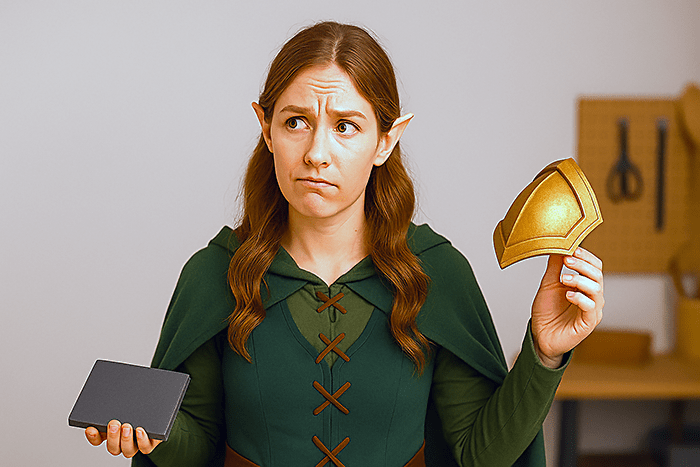Cosplaying on a Budget
Key Takeaways
- Most cosplayers spend between $100-$600 per costume, but you can create impressive looks for much less with the right approach
- Planning ahead saves significant money by avoiding rush orders and allowing time to find sales and deals
- Checking your existing wardrobe and repurposing everyday items can dramatically reduce your cosplay budget
- Simple costumes are a great starting point, costing as little as $50-$100 versus elaborate designs at $500+
- Lauren's Mystic Marketplace offers budget-friendly cosplay supplies that can serve as perfect foundations for custom costumes
Cosplay expenses can add up quickly, with the average enthusiast spending between $100 and $600 per costume. But creating stunning character transformations doesn't have to drain your bank account! With some creativity and strategic planning, you can craft incredible costumes that look professional without the professional price tag.
Understanding Cosplay Costs
Before jumping into money-saving strategies, it helps to understand what drives cosplay expenses. Several factors influence how much you'll spend on a costume. Lauren's Mystic Marketplace helps cosplayers manage these costs by providing affordable alternatives to expensive costume components.
Complexity Matters
The intricacy of your chosen character's design is perhaps the biggest cost factor. Simple costumes utilizing everyday clothing or minimal modifications might cost as little as $50-$100, while moderately complex designs typically range from $100-$300. Elaborate costumes with detailed armor, props, or special effects can easily exceed $500.
When selecting a character to cosplay on a budget, consider how complex their outfit is. Characters with simpler designs are naturally more affordable to recreate, making them perfect starting points for beginners or those watching their spending.
Materials Make a Difference
Your material choices dramatically impact your budget. Basic materials like fabric, foam, and glue might cost $50-$100, while specialized materials like resin, thermoplastics, or LED components can add hundreds to your expenses.
Budget-conscious cosplayers often substitute expensive materials with more affordable alternatives. For example:
- EVA foam instead of thermoplastics for armor pieces
- Fabric paint instead of custom-printed material
- Modified thrift store finds instead of creating garments from scratch
- Craft foam for smaller detail work rather than specialty materials
The Make vs. Buy Decision
One crucial question every cosplayer faces is whether to make or buy components. Creating your own costume can be significantly cheaper if you use readily available materials and already have basic crafting skills. However, purchasing can sometimes be more economical, especially for standardized items like school uniforms where the fabric alone might cost more than a ready-made piece.
When weighing this decision, consider not just the cost of materials but also your time, skill level, and available tools. Sometimes investing in a quality pre-made base piece and then customizing it creates better results than starting completely from scratch.
The key is evaluating each component individually. For some characters, a hybrid approach—buying certain elements and crafting others—often yields the best value for your cosplay dollar.
Plan Before You Spend: Budgeting Strategies That Work
One of the most effective ways to cosplay on a budget is strategic planning. Starting early gives you time to hunt for deals, avoid expensive rush shipping, and make thoughtful purchasing decisions.
1. Setting a Realistic Costume Budget
Before buying a single supply, determine your total budget for the costume. Break this down by components (fabric, accessories, wig, makeup, etc.) to avoid overspending in one area. Be realistic about what you can afford, and remember that creativity often trumps expensive materials for impressive cosplays.
When setting your budget, consider:
- Must-have vs. nice-to-have elements
- Areas where quality matters most
- Hidden costs like shipping or special tools
2. Planning Timeline to Avoid Rush Costs
Rush projects almost always cost more. When working under tight deadlines, you'll likely pay premium prices for express shipping, retail-priced materials, and quick alternatives when your first choice is unavailable.
Start your cosplay planning at least 2-3 months before your target event. This timeline allows you to wait for sales, compare prices, and avoid costly rush fees. Many experienced cosplayers begin planning even further ahead—sometimes 6 months or more for complex costumes—to take advantage of seasonal sales and clearance events.
3. Accounting for Hidden Expenses
Many cosplayers underestimate their total costs by forgetting to budget for accessories and finishing touches. Don't let these hidden expenses surprise you:
- Wigs and styling products
- Makeup and special effects supplies
- Contact lenses (always prioritize safety over savings here)
- Footwear and hosiery
- Props and weapons
- Basic supplies like thread, glue, and paint
While it's tempting to cut corners on some of these items, certain elements—particularly those affecting health and safety like contact lenses—should never be compromised for cost savings.
Shop Your Home First: Using What You Already Have
Before spending a dime, shop your own home. Many cosplayers are surprised by how many useful items they already own.
Start by examining your current wardrobe. That plain white button-down could become part of a school uniform cosplay. Those black boots might work perfectly for multiple characters. Even casual clothes can form the foundation of many modern or casual cosplays.
Beyond your closet, look for household items that can be repurposed:
- Bed sheets make excellent fabric for larger costume pieces
- Old jewelry can be modified for character accessories
- Cardboard shipping boxes can become the base for props and armor
- Kitchen supplies like aluminum foil and plastic containers have countless creative uses
- Old electronics can be dismantled for futuristic costume components
- Craft supplies from abandoned projects might be perfect for your cosplay
Before buying new materials, ask yourself: "Do I already own something that could work?" This simple question can save you substantial money.
Affordable Materials That Look Expensive
1. Fabric Alternatives That Won't Break the Bank
Costume fabric doesn't have to be expensive to look good. Consider these budget-friendly options:
- Polycotton blends: Affordable, easy to work with, and available in many colors
- Bedsheets: Particularly useful for larger pieces requiring substantial fabric
- Tablecloths: Often come in satin or other specialty finishes at lower prices
- Remnant bins: Check fabric stores for discounted end-of-bolt pieces
- Upcycled garments: Thrifted clothes can be disassembled for their fabric
2. Budget-Friendly Armor and Prop Materials
Creating impressive armor and props doesn't require expensive supplies. Consider these affordable alternatives:
- Craft foam: Versatile material that can be shaped, textured, and painted
- Cardboard: Free packaging can become the structure for larger props
- Hot glue: Creates texture and details without specialty sculpting tools
- Mod Podge: Seals and strengthens paper and foam creations
- Recycled plastic: Food containers can be heat-formed into armor pieces
3. Where to Find Deals on Essential Supplies
Knowing where to shop can save you significant money on cosplay materials:
- Dollar stores: Great for basic craft supplies, paint, and simple accessories
- Online marketplaces: Sites like eBay and Wish offer materials at substantial discounts
- Seasonal sales: Stock up during back-to-school, Halloween, and after-Christmas clearances
- Coupon apps: Many craft stores offer weekly coupons for 40-50% off regular-priced items
- Buy in bulk: If you cosplay regularly, purchasing larger quantities of basics like foam or fabric can reduce per-project costs
4. When to Spend More vs. When to Save
While budget cosplay is about saving money, strategic spending can actually be more economical in the long run. Here's when to invest a bit more:
- When safety is concerned (especially for contact lenses or materials near your face)
- For items you'll use across multiple costumes (like a good wig base or shoes)
- When spending more on quality will save significant time and prevent frustration
- For tools you'll use repeatedly (a decent heat gun or sewing machine)
Conversely, save on:
- Items that will only be used once
- Background details that won't be closely examined
- Materials that will be heavily modified or painted
- Components that aren't crucial to the character's recognizability
DIY vs. Store-Bought: Making Smart Decisions
1. When Buying Makes More Financial Sense
Sometimes purchasing ready-made items is actually more economical than DIY. Consider buying when:
- The item requires special skills or tools you don't possess
- The materials to make it would cost more than buying it ready-made
- You're severely time-constrained (time is a resource too!)
- The item is standardized and widely available (like plain shirts or school uniforms)
Popular budget-friendly sources for pre-made costume components include:
- Online marketplaces like eBay, Wish, and AliExpress
- Seasonal Halloween stores (especially during post-holiday clearance)
- Cosplay swap groups and secondhand marketplaces
- Consignment shops specializing in costumes or formal wear
2. Simple DIY Techniques Anyone Can Master
Even if you're not crafty, these beginner-friendly DIY techniques can save you money:
- Basic hand-sewing for simple alterations and attachments
- Painting and weathering to transform inexpensive items
- Hot glue construction for non-wearable accessories and props
- Simple fabric modifications like dyeing or distressing
Remember that you don't need fancy equipment for most cosplay projects. Expensive tools and machinery are rarely necessary for beginner to intermediate costumes. A simple sewing kit, craft knife, and hot glue gun will take you surprisingly far.
Thrift Store Transformation Tricks
1. What to Look For When Thrifting for Cosplay
Thrift stores are gold mines for budget cosplayers. Train your eye to spot these valuable finds:
- Garments with the right silhouette but wrong color (which can be dyed)
- Items with useful details like interesting buttons or trim
- Accessories that can be modified or repainted
- Fabric-rich items that can be disassembled for material
Don't just look in clothing sections. Check homegoods for fabric sources like curtains and bedding, and toy sections for props that can be repurposed. The Halloween section, even off-season, often contains valuable base pieces for fantasy or sci-fi costumes.
2. Upcycling Everyday Items Into Amazing Props
With some creativity, ordinary objects transform into impressive cosplay elements:
- Plastic bottles become the base for armor pieces or sci-fi gadgets
- Old jewelry can be painted and modified for character accessories
- Kitchen utensils become futuristic weapons or steampunk accessories
- Packaging materials like foam and cardboard become structural elements
3. Bed Sheets to Beautiful Costumes: Unexpected Materials
Common household items often make the best budget materials:
- Bed sheets provide large amounts of fabric at low prices
- Shower curtains can become waterproof or vinyl-look costumes
- Placemats and table runners often have interesting textures for details
- Craft paper and cardboard can be sealed and painted for a surprising range of finishes
Reuse and Recycle: Maximizing Your Cosplay Investment
1. Design Costumes With Multiple Characters in Mind
One of the smartest budget strategies is planning for reuse. When selecting characters to cosplay, look for those who share costume elements. For example:
- School uniform cosplays often share basic components
- Military or uniform-based characters may use similar base garments
- Fantasy characters might use the same boots, belts, or armor pieces
Design your costumes with modularity in mind, creating pieces that can be mixed and matched for different characters. This approach not only saves money but also storage space!
2. Wig Styling and Reuse Techniques
Wigs represent a significant cosplay expense, but they can be reused with proper care:
- Invest in higher-quality wigs that can withstand restyling
- Learn basic wig maintenance to extend their life
- Choose versatile colors that can be used for multiple characters
- Master techniques for temporary color changes using chalk or temporary spray
Before cutting or permanently altering a wig, consider how it might be used for future characters. Sometimes strategic styling with temporary methods can preserve its versatility.
3. Creating Modular Costume Pieces
Design your costumes with interchangeable components:
- Create base garments in neutral colors that work across costumes
- Use detachable details that can be swapped out
- Design armor and accessories with removable decorative elements
- Make reversible or modifiable pieces that can change appearance
Online Resources and Community Support
The internet is full of free resources for budget cosplayers:
- YouTube tutorials cover virtually every cosplay technique
- Cosplay forums and social media groups share tips and patterns
- Free pattern repositories offer bases for many costume types
- Discord servers and Facebook groups connect you with fellow budget-conscious creators
Don't hesitate to ask questions in these communities. Most cosplayers are happy to share their budget-saving tricks and may even have materials they're willing to trade or give away.
Before cutting into expensive fabric, make a mockup using cheap material like muslin or even bed sheets. This test run helps you perfect the fit and construction without risking costly materials, potentially saving you from expensive mistakes.
Create More With Less: Your Budget Cosplay Action Plan
Successful budget cosplay comes down to a mindset. Focus on creativity over spending, and remember that impressive costumes come from ingenuity, not just expensive materials.
Lauren's Mystic Marketplace offers quality cosplay supplies for crafters on a budget, making it easier than ever to bring your favorite characters to life without breaking the bank.



